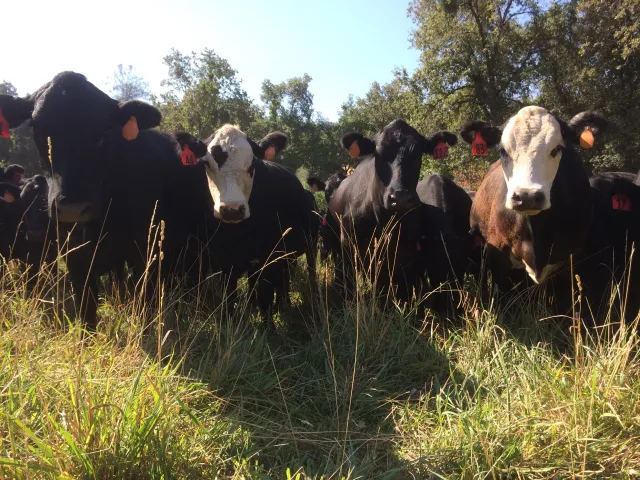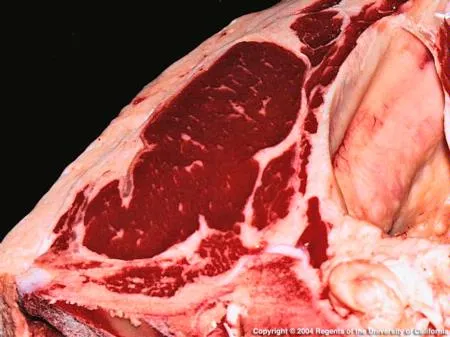A Rancher’s Guide to Understanding the Economics of Direct Marketing
When the live cattle market isn’t at record high levels (as it is currently), direct marketing beef from your ranch seems like an attractive (and profitable!) option. Even during these record prices, most of us remember the difficult years when the market is down – and direct marketing can seem like potential hedge against the bottom of the cattle cycle. But the actual economics of raising, finishing, processing, and marketing beef is more complicated than simply deciding to show up at the local farmers market with a cooler full of steaks and hamburger meat! This article is designed to help you evaluate whether direct marketing your beef makes sense. Does direct marketing beef actually add value to your cattle?

From Cow-Calf Producer to Beef Retailer
For most cow-calf producers, the “products” they sell may include weaned steer calves, replacement and/or terminal heifer calves, cull cows, and cull bulls. These sale animals may be marketed through private treaty sales, at the local sale barn, or through video auction – and the buyers are typically other cattle producers – cow-calf producers, stocker operators, or feed yards. In the case of cull animals, the buyers may be meat processors.
After your weaned calves leave the ranch, where do they go? If you wean a 600-pound steer, that animal needs to double in weight (at a minimum) to reach “finished” size and condition[i]. Most weaned calves are run as stockers (on grass) for at least a season. Following this stocker phase, feeder cattle are placed in a finishing operation (which may be a feedlot or a grass-finishing operation) to gain additional weight and fat cover.
Forage Resources
Many ranching operations design their production calendars around their annual forage calendars. For example, fall calving operations may want to be sure that their calves are big enough to take advantage of the spring flush of forage in our foothill annual grasslands. Spring calving operations may want to ensure that their cows recover enough body condition after calving to increase conception rates. Producers with access to Forest Service grazing allotments for summer forage may look slightly different than operations that rely on irrigated pasture in the summer months.
In all cases, regardless of the your particular forage calendar, you’ll need to start by balancing your stocking rate (your demand for forage) with the carrying capacity of the lands you graze (your supply of forage). Stocking rate will fluctuate during the course of the year, even with a consistent herd size. A lactating cow will need more forage – and higher quality forage – than a dry cow. Similarly, forage quantity and quality vary by season and from year to year. Most producers stock their ranches conservatively to avoid having to sell cattle during low productivity years (e.g., drought conditions).
One of the primary ways most ranchers adjust their stocking rate to changes in carrying capacity is to wean their calves. Weaning essentially cuts forage demand in half, if those calves are sold. One of the primary considerations, then, for operations that wish to retain and finish their calves is whether they have enough forage for growing calves and for maintaining cows. Alternatively, operations who decide to market beef rather than live animals may purchase stocker cattle from other ranchers.
But forage quantity is not the only consideration. Putting weight – and fat – on growing calves takes high quality forage. Are you set up to put weaned calves onto forage that will allow them to gain weight (typically, green forage with adequate protein and energy to support growth)? And if you are planning to grass finish calves for a direct marketing venture, do you have additional high quality forage to support the finishing phase?
Ranch Infrastructure
Forage quantity and quality are not the only considerations. Are your fences adequate for keeping curious feeder cattle contained? If you plan on feeding cattle through a finishing phase, do you have the facilities and equipment necessary to do this efficiently?
If you plan on marketing meat, your infrastructure needs don’t stop at the pasture! Do you have adequate cold storage to manage beef inventory? Do you have the ability to transport meat from the processor to your storage facility while maintaining temperature control? Do you have an inventory management system in place? What about retail facilities or equipment for marketing beef at a farmers’ market?
Ranch Labor vs. Meat Marketing Labor
Ranch owners and employees, obviously, need a wide range of skills. You need to be able to treat sick cattle, move livestock safely and efficiently, drive and fix equipment, build and repair fence, manage natural resources, and run a business (and the list could go on!). Marketing meat requires different – but equally diverse – skills. You need to be able to determine what cuts of beef your consumers are willing to buy, to understand pricing structure (your own and your competition’s), to manage inventory and distribution. Direct marketing requires someone who likes to talk to people, who doesn’t mind explaining the story of your ranch multiple times during a farmers’ market. You’ll need someone to contact restaurants and retailers – and invoice these customers when they make a purchase. Do you have someone in your business who can handle this work? Alternatively, if you’ll be doing the marketing and sales work, who will be covering the ranch work?
Knowing your Cattle vs. Knowing your Beef
If you’ve raised cattle for more than a few years, you probably know your cow herd pretty well. You know which cow consistently raises a big calf, and which cow will try to take you out when you ear tag her calf. If you’ve sold calves to the same buyer year after year, you may have some data on how your calves perform (as stockers or on the rail).
But do you know the attributes of your beef? What does an animal that is likely to grade choice look like on the hoof? What kind of dressing percentage can you expect from your cattle? More importantly, what kind of retail cutout can you expect? When that 1,400 pound steer is harvested, how many ribeye steaks will you have to sell? How much ground beef and stew meat will you need to market? How will you price these specific cuts at a level that consumers will accept and that will generate a profit for your business?
Risks
Most ranchers are familiar with the risks involved in raising cattle. Production risks like drought, disease, predation, and wildfire can impact profitability, as can human risks like injuries, and legal risks like cattle being struck by a vehicle on a county road. Each operation has its own unique risk tolerance, and most operations manage this risk through a combination of planning and insurance.
Direct marketing businesses bring additional risks. From a production risk standpoint, death loss and disease are a risk at every additional production phase (when you sell your calves at weaning, the buyer assumes the risk of death loss; when you keep your calves through harvest, this risk is yours). Even after harvest, you’ll face additional production risks – what if your freezers fail, or a processor closes down? The human and legal risks are different, too. What if a farmers market customer trips and falls in your stall on Saturday morning? What if someone contracts a food borne illness and blames it on the meat they brought from you?
Again, every operation will have its own risk tolerance, but you will need additional insurance. Your ranch liability policy will not likely cover product liability, nor will it cover liability related to you farmers’ market stall.
Customers vs. Consumers
Consumers are the people that eat your beef. Customers are the people who pay for it. In some cases, this may be the same person. In other cases (as with restaurants or direct-to-retail outlets), the customer may not be the consumer. Obviously, you’ll need to understand each customer’s motivation and price sensitivity. For example, a chef tries to keep the food cost to 30% of the menu price. That steak on that $30 menu item must cost the restaurant less than $9. Can you meet that price and still be profitable?
Running the Numbers
To truly analyze whether selling beef is more profitable than your current production model, you’ll need to crunch the numbers. Remember, when you take a load of weaned steers to the auction, you get paid within a week. If you’re going to finish these steers rather than sell them at weaning, the stocker, finishing, and meat segments of your business need to “purchase” the animals going into each phase (even if this is just on paper). In other words, at each step of the business, you must decide – do I sell these cattle to someone else, or do I retain ownership through the next phase. And each phase has its own unique costs, risks, and potential rewards!
To help you analyze these opportunities, I have created a spreadsheet that is designed to help you look at the bigger picture – at the end of this entire production process, does selling meat actually ADD value to the calves you produce? If you would like to use this spreadsheet to analyze YOUR direct market business, contact me at dmacon@ucanr.edu – I am happy to walk you through the numbers!
Operational Questions
These questions are designed to help you and your team (family, employees, etc.) walk through the complex considerations that go into marketing your cattle. The purpose of this questionnaire is to help you identify strengths and weaknesses in your current business model, as well as opportunities for new revenue streams.
- What classes and weights of cattle do you currently market? When do you market them? Where do you market them?
- What does your current forage calendar look like? Where are each class of cattle during the course of the year, and what are they grazing in terms of forage type and quality?
- Do you have any experience running stocker cattle?
- Do you have any experience finishing cattle?
- What class(es) of cattle are you considering using in your direct market business? Steers? Heifers? Cull cows?
- Have you tested the market? Eaten your own beef? If so, what is great about YOUR beef?
- What is the story that goes with your beef? What makes your operation unique?
- How will you market beef? Through a farmers’ market, to restaurants, as whole/half/quarter carcasses directly to consumers, through a buying club?
- Who is your customer? Who is your consumer? What motivates each of them?
- Do you have post-harvest infrastructure in place (commercial freezers, a refrigerated truck, etc.) or will you need to purchase or rent this equipment?
- Who will manage the beef inventory? Who will make deliveries and/or service customers? Who will coordinate processing, labeling, etc.? Who will do invoicing and collect payment?
Conclusion
This probably seems like a lot to consider – and it is! Deciding how to market your cattle – whether as weaned calves through a video sale or as packages of beef – impacts your cash flow, profitability, and business equity. Hopefully, the questions above, and the spreadsheet linked to this article, will help you think through your options objectively. If you have questions, or if you would like assistance walking through this analysis, contact me at dmacon@ucanr.edu!

[i] Finished condition refers to the degree of external fat and intramuscular fat (or marbling). USDA quality grades (e.g., Prime, Choice, Select, etc.) reflect this degree of intramuscular fat. Under-finished cattle typically won’t provide your consumer with a satisfactory eating experience.
